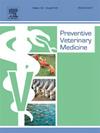A scenario model to support freedom from African swine fever virus in Western Canada populated with data from Canada West Swine Health Intelligence Network and CanSpotASF
IF 2.4
2区 农林科学
Q1 VETERINARY SCIENCES
引用次数: 0
Abstract
African swine fewer (ASF) is a serious disease present in Africa, Eurasia, and the Caribbean but not in continental North America. CanSpotASF describes the ASF surveillance in Canada. It enhanced the passive surveillance by adding new surveillance components one by one. The first enhancement was “the risk-based early detection testing (rule-out testing)” where cases with eligible conditions were tested for ASF virus (ASFv). The rule-out testing started in 2020 and we have over 3 years data in the Canada West Swine Health Intelligence Network (CWSHIN) data repository on ASFv rule-out testing. The objectives were to develop and assess a scenario tree model (STM) for ASFv freedom to support the claim that commercial swine in Western Canada were free from ASFv; to assess if the CWSHIN repository data may be useful in the STM; and to assess if the rule-out testing had contributed to more evidence of freedom from ASFv than we would have had with passive surveillance alone. To compare and assess different scenarios we used the model’s ability to accumulate evidence of freedom from the July quarter in 2020 to the July quarter in 2023 (13 quarters). We concluded that a method to assess the ability of a scenario and model to accumulate evidence of freedom, based on increasing probability of freedom that approached an equilibrium and a system sensitivity of at least 0.2–0.3, was useful. The CWSHIN data repository was critical to populate the model because it included both number of clinical assessments by herd veterinarians (from quarterly surveys); routine diagnostic data (pathology examinations) and ASF testing results from laboratories. The take home message was that the probability that a herd veterinarian will report a suspicion of ASF to the Canadian Food Inspection Agency (CFIA) (seVet) affected the outcomes of the STM. If the probability that a herd veterinarian reports to CFIA is low (seVet=0.01), then pathology examination and CanSpotASF will improve the STM outcomes. If the probability that a herd veterinarian reports to CFIA is high (seVet is 0.7 or higher), then there is no need for additional pathology and CanSpotASF testing. We expect the actual probability of reporting and subsequent value of additional pathology and testing to between these two scenarios.
加拿大西部猪健康情报网和CanSpotASF提供的数据支持加拿大西部摆脱非洲猪瘟病毒的情景模型
非洲猪少瘟(ASF)是一种严重的疾病,存在于非洲、欧亚大陆和加勒比地区,但不存在于北美大陆。CanSpotASF描述了加拿大的非洲猪瘟监测情况。通过逐个添加新的监控组件,增强了被动监控功能。第一个加强措施是“基于风险的早期检测(排除检测)”,对符合条件的病例进行非洲猪瘟病毒检测。排除测试始于2020年,我们在加拿大西部猪健康情报网(CWSHIN)数据库中有超过3年的ASFv排除测试数据。目的是开发和评估非洲猪瘟自由的情景树模型(STM),以支持加拿大西部商品猪没有非洲猪瘟的说法;评估CWSHIN资料库的资料是否可用于技术管理;并评估排除测试是否比单独被动监测提供了更多的ASFv自由的证据。为了比较和评估不同的情景,我们使用了该模型积累从2020年7月季度到2023年7月季度(13个季度)的自由证据的能力。我们的结论是,一种评估情景和模型积累自由证据的能力的方法是有用的,该方法基于接近平衡的自由概率的增加和系统灵敏度至少为0.2-0.3。CWSHIN数据存储库对于填充模型至关重要,因为它包括兽群兽医的临床评估数量(来自季度调查);常规诊断数据(病理检查)和实验室非洲猪瘟检测结果。关键的信息是,兽群兽医向加拿大食品检验局(CFIA)报告疑似非洲猪瘟的可能性会影响STM的结果。如果兽群兽医向CFIA报告的概率较低(seVet=0.01),则病理学检查和CanSpotASF将改善STM结果。如果兽群兽医向CFIA报告的概率很高(seVet为0.7或更高),则不需要进行额外的病理和CanSpotASF检测。我们期望在这两种情况之间报告的实际概率和后续附加病理和测试的价值。
本文章由计算机程序翻译,如有差异,请以英文原文为准。
求助全文
约1分钟内获得全文
求助全文
来源期刊

Preventive veterinary medicine
农林科学-兽医学
CiteScore
5.60
自引率
7.70%
发文量
184
审稿时长
3 months
期刊介绍:
Preventive Veterinary Medicine is one of the leading international resources for scientific reports on animal health programs and preventive veterinary medicine. The journal follows the guidelines for standardizing and strengthening the reporting of biomedical research which are available from the CONSORT, MOOSE, PRISMA, REFLECT, STARD, and STROBE statements. The journal focuses on:
Epidemiology of health events relevant to domestic and wild animals;
Economic impacts of epidemic and endemic animal and zoonotic diseases;
Latest methods and approaches in veterinary epidemiology;
Disease and infection control or eradication measures;
The "One Health" concept and the relationships between veterinary medicine, human health, animal-production systems, and the environment;
Development of new techniques in surveillance systems and diagnosis;
Evaluation and control of diseases in animal populations.
 求助内容:
求助内容: 应助结果提醒方式:
应助结果提醒方式:


